Are you ready for your dream trip to the South Pacific’s beautiful islands? Or could a visa misunderstanding ruin your plans? Knowing the visa rules in the South Pacific is key for U.S. travelers. Some islands don’t need a visa, but others have rules you might not know about.
This guide will help you understand visa rules in the South Pacific. It’s all about making your trip to places like Fiji, Tahiti, the Cook Islands, and Samoa smooth. You’ll learn which islands need visas and how to prepare.
Key Takeaways
- The South Pacific has varied visa policies that all travelers should understand.
- Not all islands in the South Pacific require visas for entry.
- Checking specific visa requirements can save you from last-minute travel hassles.
- Preparing documentation ahead of time can make your application process smoother.
- Understanding entry permits can help distinguish between visa types.
Understanding South Pacific Travel Visas
Traveling to the South Pacific is a dream come true. But, you must first understand the visa rules. Each island has its own visa rules for travelers. Some allow you to enter without a visa for a short time. Others need you to get a visa before you go.
Knowing these rules is key to a smooth trip. It helps avoid any last-minute problems.
Overview of Visa Requirements in the South Pacific
Visa rules differ across the South Pacific islands. Fiji and Samoa let some visitors in without a visa for 30 days. But, Tonga might need you to get a visa before you arrive.
It’s important to know the visa rules for each island. Always check the latest rules before you go. Visa rules can change often.
Importance of Checking Visa Regulations
Knowing the visa rules is very important. Policies can change, affecting your entry. You might need to show proof of travel plans, where you’ll stay, and health checks.
Following these rules makes your trip better. It also avoids unexpected issues.
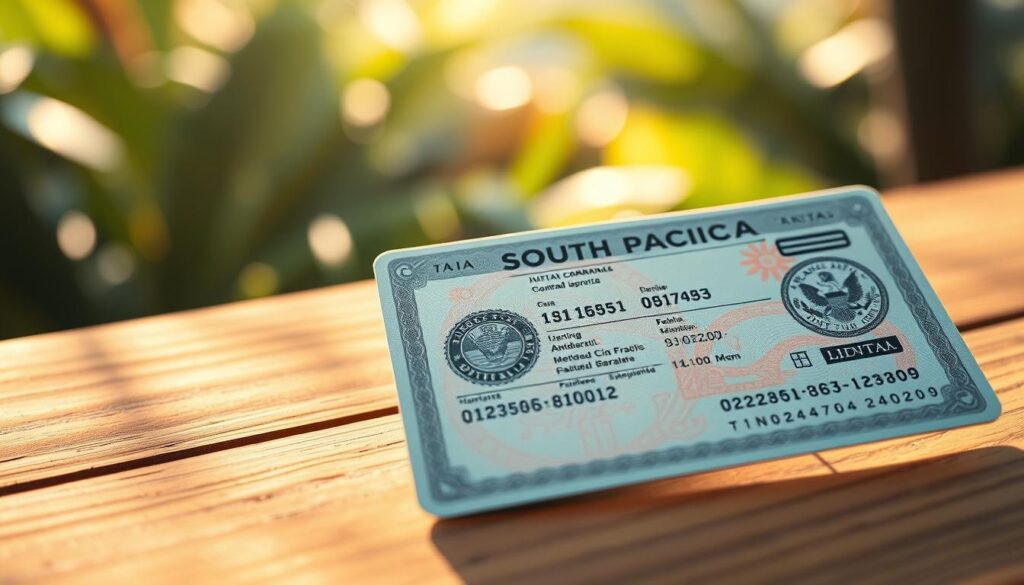
Countries in the South Pacific and Their Visa Policies
The South Pacific is known for its rich cultures and beautiful landscapes. Knowing the visa rules in these places is key for a smooth trip. Each country has its own visa rules, affecting your travel from island to island. Learning about these rules can help avoid any travel hitches.
Overview of Different Visa Policies by Country
Exploring visa policies in the South Pacific shows different rules for each country. These rules depend on your nationality and how long you plan to stay. Here’s a quick guide:
| Country | Visa Requirement | Duration of Stay |
|---|---|---|
| Fiji | Visa on Arrival | Up to 4 months |
| Cook Islands | Visa-Free | 31 days (extendable) |
| Tahiti (French Polynesia) | No Visa Required | Up to 90 days |
| Tuvalu | Visa on Arrival | Up to 30 days |
Island Nations in the South Pacific
Understanding visa rules for each island is vital. Each place has its own rules for visitors. This makes the South Pacific special, as it invites travelers to discover each country’s culture and entry rules.
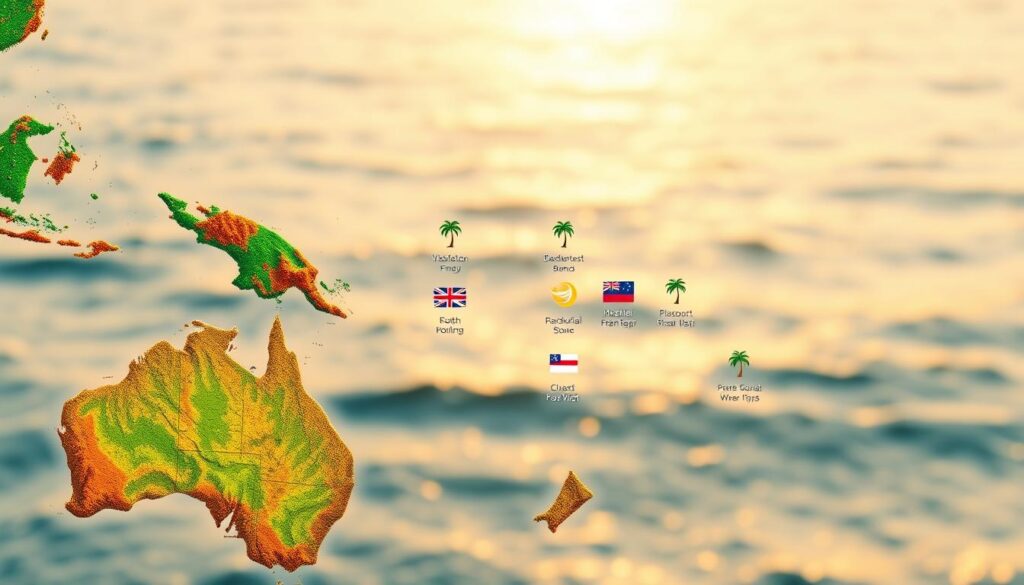
South Pacific Visa Guide: Which Islands Require a Visa?
Traveling to the South Pacific is a chance to see beautiful landscapes, diverse cultures, and friendly people. Knowing which islands need a visa is key for US travelers. Some places welcome you without a visa, while others need more preparation. This guide will help you understand which islands are visa-free and which need a visa.
Visa-Free Islands for US Travelers
Many South Pacific islands let US travelers in without a visa. Some of these include:
- Fiji: Enjoy up to 120 days without a visa.
- Cook Islands: Visa-free access for up to 31 days.
- Tahiti (French Polynesia): Stay up to 90 days without a visa.
Islands Requiring Visa Applications
Even though many islands don’t need a visa, some do. It’s important to get the latest visa info to travel smoothly. Islands that need a visa application include:
- Papua New Guinea: A visa must be obtained prior to travel.
- Vanuatu: Travelers are advised to apply for a visa ahead of time.
- Solomon Islands: Advance application for a visa is necessary.
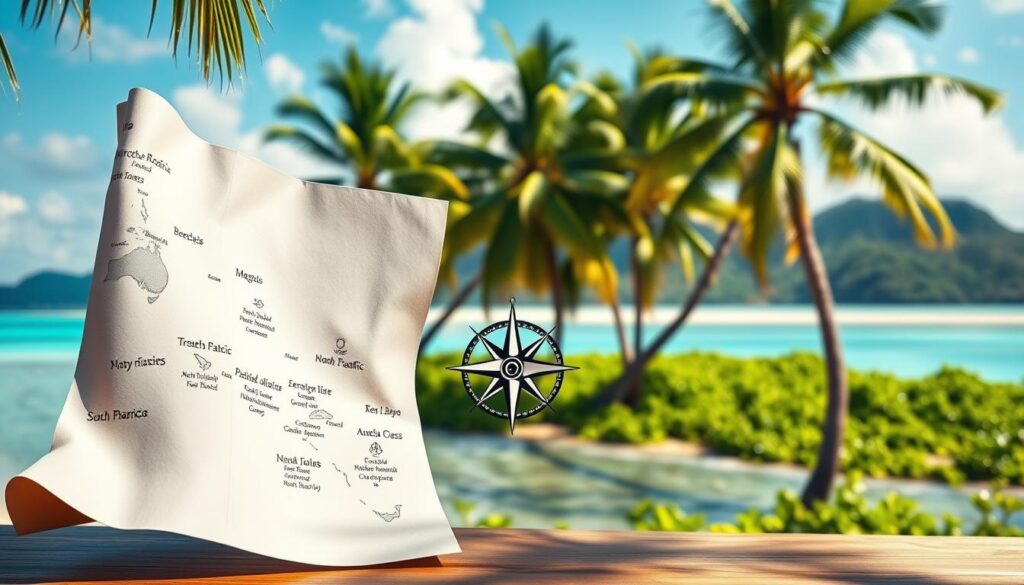
Visa Application Process for South Pacific Islands
Traveling to the South Pacific means understanding the visa application process. It involves several key steps for a smooth application. By following these steps, you can easily apply for a visa.
Steps for Applying for a Visa
To apply for a visa, follow these essential steps:
- Determine the visa type you need based on your travel plans and island rules.
- Fill out the visa application form correctly, making sure all sections are completed.
- Pay the visa fee, which changes based on the island and visa type.
- Submit your application with the needed documents, which support your travel plans.
Documentation Required for Visa Applications
Getting the right documents is key for a successful application. Here are the common documents needed:
| Document | Description |
|---|---|
| Valid Passport | Your passport must be valid for at least six months after your planned departure. |
| Proof of Onward Travel | Show a copy of your return flight or travel itinerary to prove your plans. |
| Evidence of Accommodation | You may need to show hotel reservations or an invitation from a host. |
| Financial Statements | Documents showing you can support yourself financially during your stay may be needed. |
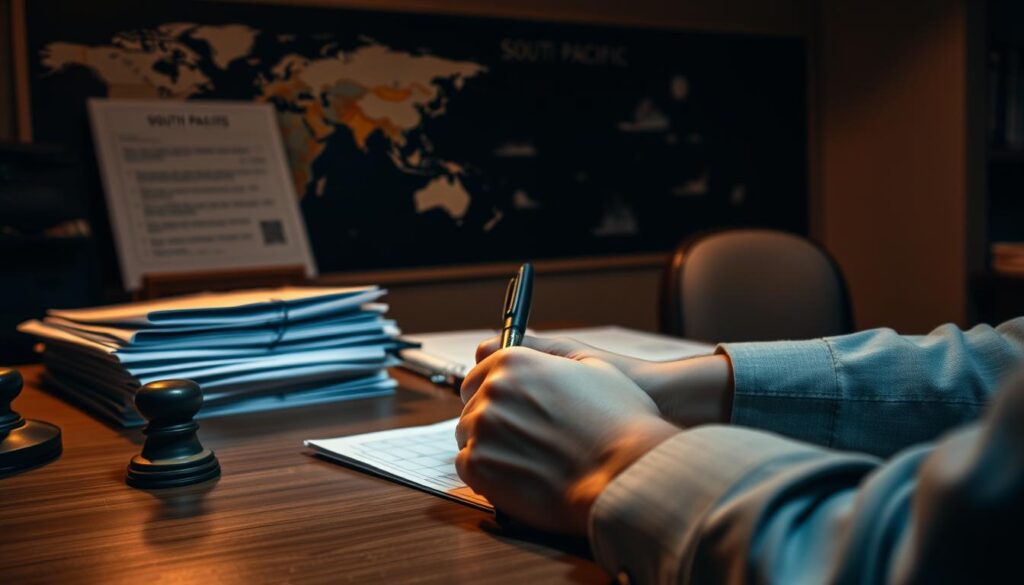
Visa on Arrival Policies in the South Pacific
Traveling to the South Pacific is an amazing adventure. Many countries offer visa on arrival, making it easy to get your visa at the airport. This policy saves you from pre-travel paperwork, making your journey smoother.
Countries Offer Visa on Arrival
Several South Pacific nations have adopted visa on arrival policies. This is great for tourists who want an easy entry. Here are some key places:
| Country | Duration of Stay | Requirements |
|---|---|---|
| Fiji | Up to 4 months | Valid passport, proof of onward travel |
| Samoa | Up to 60 days | Valid passport, proof of funds for the stay |
| Tonga | Up to 31 days | Valid passport, return ticket |
| Vanuatu | Up to 30 days | Valid passport, proof of onward travel |
Requirements for Visa on Arrival
The visa on arrival in the South Pacific makes entry easier. But, there are key things you need. You’ll typically need:
- A valid passport with at least six months of validity remaining
- Proof of onward travel, like a return ticket or a ticket to your next destination
- Documentation showing enough money for your stay
Knowing about visa on arrival policies in the South Pacific can make your trip better. It prepares you for a smooth arrival in these stunning places.
Common Visa Restrictions in South Pacific Nations
Traveling to the South Pacific is a treat with its beautiful views and diverse cultures. But, knowing the visa rules is key. Each country has its own rules about how long you can stay and what you can do. Knowing these rules helps you have a great trip and avoids trouble with immigration.
Length of Stay Guidelines
The length of stay varies across islands. Some places let you stay up to 90 days, while others limit it to a few weeks. It’s important to check the visa rules for each place you plan to visit.
- Fiji: Typically a 120-day stay for many passport holders.
- Tonga: A maximum stay of 30 days for most visitors.
- Samoa: Allows you to stay for 60 days without a visa.
- Vanuatu: A 30-day stay upon arrival is common.
Prohibitions on Certain Activities
Some activities are off-limits due to visa rules. Working without permission can cause legal problems. Some places also ban public demonstrations. Always check local laws to stay out of trouble.
“Knowledge of local customs and regulations enhances the travel experience, ensuring respect for the resident community.”
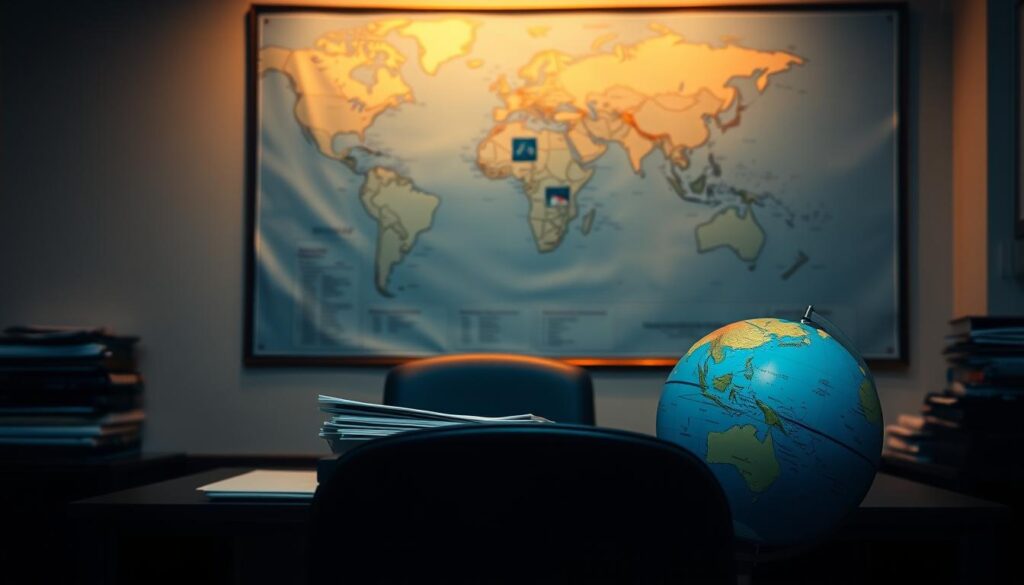
Entry Permits for South Pacific Nations
Traveling to the South Pacific requires knowing about entry permits for each island. These permits let visitors stay for a short time, allowing them to see the islands’ beauty and culture. While similar to visas, entry permits have their own rules and requirements. It’s important for anyone planning a trip to understand these differences.
What Are Entry Permits?
Entry permits are official documents that let foreign visitors into certain countries for a short time. They are needed for some South Pacific nations and can vary in length and purpose. Depending on your visit, you might need a tourist, business, or temporary resident permit.
Differences Between Visas and Entry Permits
Visas and entry permits differ in how you apply and what you need. Getting an entry permit might be easier than a visa in some cases. Also, entry permits often last longer. Visas, on the other hand, might need more paperwork and take longer to process. Knowing about visa policies in the South Pacific can help you choose the right option for your trip.
Travel Documents Required for South Pacific Islands
Before you start your journey to the South Pacific, make sure you have the right travel documents. Each island has its own rules, so knowing what you need is key. Understanding your essential travel documents will help your trip go smoothly.
Essential Travel Documents for Visiting Islands
Here are the documents you’ll need for your trip:
- Valid Passport: Your passport should be valid for at least six months after you plan to leave.
- Visa: You might need a visa, depending on where you’re going. Check the rules for each country.
- Return Ticket: You’ll need to show proof of a return flight.
- Proof of Accommodation: Having a confirmation of your stay can be helpful.
- Health Documentation: This includes valid passports and vaccination records. Some places require specific vaccines.
Importance of Valid Passports and Vaccination Records
Valid passports are essential for traveling internationally, like to the South Pacific. Make sure your passport is up to date to avoid problems at customs. Vaccination records are also vital. Some islands require proof of certain vaccines, like for diseases common in the area. Keep these documents with you for easy entry.
Health and Safety Considerations for South Pacific Travel
Traveling to the South Pacific requires careful health and safety planning. Make sure you have the right vaccinations and know the best practices. This way, you can enjoy the islands’ beauty and culture fully.
Recommended Vaccinations Before Traveling
Before you go, think about the recommended vaccinations before traveling. Vaccines like Hepatitis A, Hepatitis B, typhoid, and measles are key. Your doctor will give advice based on your trip and health history.
Best Practices for Health and Safety
While exploring, remember the best practices for health and safety. Here are some tips:
- Use insect repellent to protect against mosquito-borne diseases.
- Stay hydrated, as the climate can be warm.
- Drink bottled water and follow food safety tips.
- Know where to find medical help and resources.
By knowing the health and safety considerations for south pacific travel, you’ll have a great trip.
| Vaccination | Recommended For | Notes |
|---|---|---|
| Hepatitis A | All travelers | Especially beneficial for food and water safety |
| Hepatitis B | At-risk travelers | Recommended for longer stays or possible exposure |
| Typhoid | Travelers to rural areas | Good if you eat local foods |
| Measles | All travelers | Outbreaks can happen, so vaccination is key |
Conclusion
Traveling to the South Pacific islands requires understanding visa requirements. Each island has its own rules, affecting your trip. The South Pacific visa guide helps you know what you need for each place.
Knowing the visa rules makes your trip better. It lets you enjoy the culture and beauty of the islands fully. This knowledge is key to a great travel experience.
Before you go, learn about visa rules for the South Pacific. This guide helps you prepare and follow travel rules. It ensures your trip is both enjoyable and smooth.
